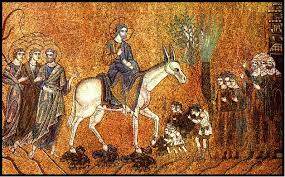Jesus’ Entry into Jerusalem; c. 1409; illuminated miniature on parchment from the Très Belles Heures of the Duc de Berry; Museo Civico d’Arte Antica, Palazzo Madama, Torino.
The Entry into Jerusalem
To understand
Jesus riding an ass is acclaimed by the crowd waving branches of foliage.
Jesus is generally riding astride and bare-headed even if oriental influences can bring the artist to represent him riding side-saddle and crowned.
The mount should be small since it is the foal of an ass that has never been ridden but, for reasons of proportion, it is generally fairly big and white, grey or even black.
The apostles follow Jesus, Peter in front, but they play no part in the scene.
The crowd is thick and made up of men, women and children of all conditions. Some spread their cloaks in front of Christ, many acclaim him while waving palms while some have climbed into the trees the better to see him. According to an apocryphal text, among them is to be seen Zacchaeus, the Publican from Jericho whom Jesus has already found at the top of a sycamore. (Luke 19:2).
This entry resembles an antique triumph but on an ass.
Not be confused with
|
The Ass of Balaam; REMBRANDT; 1626; oil on panel; Musée Cognacq-Jay, Paris.
|
Balam's ass Balaam is a prophet of Mesopotamia who must curse the Israelites. He starts on a journey riding an ass but God places in his way an angel who frightens the mount…Eventually Balaam will bless the Sons of Israel (See the Book of Numbers, chapters 22 to 24). Except for the man riding a she-ass, there is no common element between this scene and that of Jesus entering Jerusalem. |
The biblical narrative
The Gospel according to Matthew, chapter 21
And when they drew near Jerusalem, and came to Bethphage, at the mount of Olives, then Jesus sent two disciples, Saying to them, Go into the village opposite you, and straightway you shall find an ass tied, and a colt with her: loose them, and bring them to me. And if any man says anything to you, you shall say, The Lord has need of them; and straightway he will send them. All this was done, that it might be fulfilled which was spoken by the prophet, saying, Tell the daughter of Sion,
Behold, thy King is coming to you,
meek, and sitting on an ass,
a colt, the foal of an ass.
And the disciples went, and did as Jesus commanded them, And brought the ass, and the colt, and put their clothes on them, and they set him on them. And a very great multitude spread their garments in the way; others cut down branches from the trees, and spread them in the way.
And the multitudes that went before, and those that followed, cried, saying,
Hosanna to the Son of David:
Blessed is he that comes in the name of the Lord;
Hosanna in the highest.
And when he had come into Jerusalem, all the city was moved, saying, Who is this? And the multitude said: This is Jesus the prophet from Nazareth of Galilee.
(Matthew 21:1-11)
Comment
Jesus proclaims himself and is really recognized as the Messiah entering into the Holy city while being acclaimed by the Hosanna of Psalm 116. A sharp contrast with the narratives of the Passion that follow.
See similar pictures
|
Two traditional representations following the details of the text: the cloak, the children in the trees… |
The Entry into Jerusalem; 1st part of the 12th century; miniature from the Psalter of St Albans; Historic Collection, University of Aberdeen, Scotland
|
The Entry into Jerusalem; GIOTTO; 1304-06; fresco; Scrovegni Chapel, Padua
|
|
A slightly hieratic representation in the mosaic inspired by the Orient: the hooves of the she-ass tread only on cloaks. On the contrary, the Russian painter plays on the closeness between Jesus and the crowd. |
Jesus’ Entry into Jerusalem; 12th century mosaic
|
Jesus’ Entry into Jerusalem; Henryk Hector SIEMIRADZKI; 1876; sketch for a mural painting of St Saviour’s cathedral in Moscow, Russian Museum, St Petersburg.
|
|
Two more modern representations: Gill focuses on Christ, while Ensor actualises Jesus’ entry by giving it a revolutionary character and transferring it to Brussels. |
Christ entering into Brussels in 1889; Jacques ENSOR; 1888; oil on Canvas; J. Paul Getty Museum, Los Angeles.
|
Palm Sunday; Eric GILL; 1882-1940; print on paper; Tate Collection, London.
|
Further developments
This entry into Jerusalem has been and is still celebrated under the name of Feast of Palms.The faithful pick up palms, branches of laurel or boxwood, according to regions, to acclaim Christ. These evergreen shrubs should be put into relation with spring but, unlike other feasts, no previous celebration of spring is known even if some magical rites can be found in it.
Palm Sunday is fixed on the Sunday before Easter; it begins the so-called Holy Week since the latter commemorates the Passion of Christ. Palm Sunday in Orléans, France.
|








